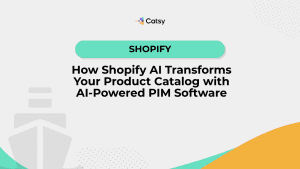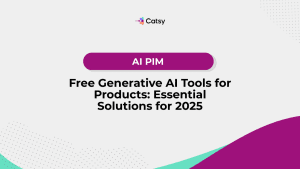Product Information Management for Distributors

- Product Information Management (PIM) can empower Distributors to speed products to market, creating more opportunity for sales.
- With a PIM & DAM solution, Distributors can create a single source of truth for all product content sent in from vendors in a variety of different formats.
- Distributors need a software solution that can optimize processes to manage and maintain a high-volume of products.
In this Article
If you consider the sheer number of marketing channels a modern distributor has to think about, it can boggle the mind. You might have several different Print projects going on (perhaps some weekly promos, or monthly brochures or mini-catalogs, along with the “Full Catalog”). At the same time, you have to make sure the Web Catalog is in sync. You may want to launch a Mobile App at some point. If you’re managing data for all of these separate outputs as individual data projects, you’re duplicating your work.
With a well-designed product database, you get your valuable data into one Master Repository. This singular repository is then used to drive all of the other outputs. The Full Catalog print project is just an “event” (or collection of products). Same as the brochures and flyers.
The Web Catalog is just another event. Several different events can include the same products, but will probably not display some while including others, and vice versa. Each is able to be individually maintained, but the CORE product data all comes from ONE place.
There is no limit to the number of fields of information that can be defined with your database. You can create as few or as many as you need. If you want to display a slightly different version of copy on the Web than you do for Print.just create a separate field. If you want to introduce Zone Pricing..just create the fields. They are instantly available to all products that need them, and ready to have data imported.
Item and Group Concepts Are Key To Consolidation
Just about everyone understands what you mean by an “Item” or a “SKU” or a “Product”. It’s basically anything that can be individually tracked, sold, and shipped to a customer. A screw in a certain size and coating would have its own Item #. As would an individually wrapped food item meant for individual resale. A “Monster HDMI” cable with ultra-advanced specs is an Item, as is a low-priced alternative that just barely meets HDMI standards.
Now, take for instance the example of the screw again. What differentiates this screw, most likely, is the application and head type. So, it may be a wood screw (not suitable for metal or plastic), and it may have a unique Torx head that is only used by special Torx drivers. This is the key information that separates this type of screw from others.
However, consider that this screw comes in about 30 different sizes: ranging from ¼” to 4 ½”in length. Now, each one of these 30 sizes represents an individual ITEM, because someone needs to be able to buy the ¼” version but not the 4″ version. But, do these 30 individual versions of the same screw need separate copy, or their own image? No, of course not! The image of the Torx-head tells all we need to know about all 30. The bullet point copy describing which applications these are good for also applies to all 30. In cases like this, Catsy calls the entire grouping of 30 individual items an “Item Group”.
An Item Group is essentially a wrapper that takes a common image (or images), which apply to all items contained, along with shared copy that also applies to all items contained. The individual items then tend to be displayed as a “List” format, with maybe a few key fields: ITEM #, Length, and Price. This will change of course from one product type to the next, but the general idea remains.
You need to display the Item # so buyers know what to order. They need to see Length so they get the right size screw. This is most efficiently displayed as a list of items, so you don’t have 30 individual product blocks all showing the same image of the screw, with the only difference being the length!
With our product catalog software utilizing the Item Group concept, your products can be databased in a way that ensures maximum efficiency while tying everything together. It also makes it easy to display disparate products all in the correct way, whether it’s a print project or for the web.
Specification Fields Ideal For E-Commerce Site
Specification fields are how we manage attributes that apply to only a certain Category of products, but not others. These fields tend to be technical in nature and are all-important because these specs must meet or exceed the buyer’s very specific set of requirements. Consider a case where someone is looking to replace a pump and filter for a commercial 2500 gallon aquarium. Something this large would require a pump that has an extreme GPM (gallons per minute) flow to adequately move enough water through the filter. Also, the filter would need to be quite large and probably be built specifically for a tank of this size.
When perusing specs for pumps & filters, it is possible to quickly rule out products that simply are in no way able to meet those specs. For instance, a product page with a column for “GPM” would tell you right away that something with a value of “25” or “50” is far too low to meet your needs; pumps of this size would be more in line with a small 25-50 gallon home aquarium. Most likely there would be another spec column called “Good For Applications Up To”, which lists the size in gallons the pumps/filters are intended for.
This way, a prospective buyer can quickly skip past the products that aren’t anywhere close to serving their purpose, while making a beeline right for the area of “2500 gallons”. Something in this range could fill their needs, but of course, there may be other specifications they are concerned about.
If your E-Commerce site does not adequate display these Specifications for your products, you are going to lose a lot of business because buyers expect correct and up-to-date data, particularly when it comes to technical specifications. They base their entire purchasing decision on whether or not the listed products “meet their specs”. With Catsy, this is supported right out of the box and we provide an easy way to showcase and manage your Specification fields. Those with a large number of specification fields may want to create something called “Specification Sheets”, aka “Spec Sheets” or “Tech Specs”. To learn more about this, read my last post about this subject by clicking HERE:
Security Features Allow For Smooth Separation Of Workflow For Your Teams
There’s simply too much work involved with catalog management unless we can effectively parallelize the work. If we need to wait for Bob the data guy to fully get the corrections in from the latest proofs, before we begin to update the images using the latest from the Photography department, or before we apply the latest Pricing updates, we’re going to waste a lot of precious time. We need a simple and effective way to make sure everyone can get their work done while not stepping on each other’s toes and causing further aggravation. We consider this a key function of our product catalog software.
With Catsy’s advanced security measures, it’s a breeze. Each individual user can be assigned to different security “roles” (or departments, if you will). These departments, such as “Photography”, “Copywriter”, and “Product Manager”, all can have separate rights and abilities as far as what they can see or what they can change, within the centralized product database. For example, the Pricing fields may be completely Hidden to “Photography” and “Copywriter” while the “Product Manager” has full access to view and edit those fields.
You can even break down your access by individual catalog projects. For instance, some teams could be given access to the new “2015 Full Catalog” project, while others do not see it yet. All of these rights and abilities can be set up right within the tool, and changed at a moment’s notice by those with “Admin” capabilities.
Spread Your Wealth Of Product Content
Getting your valuable data into the product database is only the tip of the iceberg. While there are a ton of benefits to organizing your data in a professional manner, the real power lies in your ability to more quickly and easily get this goldmine of data OUT to your various channels and projects. With Catsy, you have a variety of weapons at your disposal.
Export
You can quickly select any grouping of products in your database and Export out selected fields. As an example, you could Export all product pricing fields under the “Bicycle Helmets” section. You could then pass this Excel file on to get a quick pricing update, and then bring it back in via Import. This applies to any fields, really.
PDF Creator
You can select a grouping of products, apply a pre-styled “template” to them (which determines the look and feel of the catalog), and add some key information to the Header/Footer areas like Company Name, Phone Number, Website, etc. along with your colors for Branding, and generate a high-res PDF catalog in minutes. There are a number of applications for this.
One, you could pass this on to someone else as an actual catalog because it’s high enough quality. Two, it could be used as a method for Data Proofing, because passing on this version of the catalog contains the latest from the centralized product database. Any corrections that need to be made could be marked up and then once the changes are made on the database side, another PDF Proof can be generated.
Web Catalog
Because your product data all pulls from the same database, you don’t need to manage data separately for your “print projects” versus “website” versus “mobile catalogs”, or anything else. Maintain your data one time and in one place, and your web catalog can actually be driven completely from this same repository with no extra management other than determining which products are included.
Manage Images Effectively, Efficiently, And Effortlessly
Image “Management” for many of us consists of trying to remember what machine or what folder we’re pretty sure we last saw a particular image that we happen to need at the moment. This isn’t due to a lack of effort in most cases; it’s just that there are a number of valid issues when it comes to managing a large amount of images. It is important to understand what the issues are before we can go about attempting to solve them. So, here are some of the most common problems:
Images Coming From Multiple Sources – Think of a typical distributor. How many products, on average, are we talking about? 20,000? 100,000? 250,000+? The point is, it’s a lot. And each one of those products would typically need one product photo at a minimum, but most likely we’re talking about several. Besides the main “product photo” you might have alternate shots, line drawings, back / side / front / top view shots, grayscale, barcodes, etc. etc. So in most cases the number of images we’re talking about is a MULTIPLE of the number of products.
The sheer number of images isn’t even the biggest concern-it’s that you’re depending on them coming from a variety of sources. Some manufacturers may be more reliable than others when it comes to providing images that you need on a timely basis. Each manufacturer will have their own FTP access or method for getting images to you, and these all need to be managed as well.
Images Of Varying Quality
Another big problem is that with so many disparate sources, quality control of your images is extremely difficult to maintain. One manufacturer may give you high-resolution TIFs, another may give you (at best) web quality JPEGs, still another may give you a format you don’t want to use at all, which means you’re now looking to convert their images to even use them. Even if you’re able to get images in your preferred format, there is still the question of resolution and other quality settings.
Lack Of Image Naming Convention
Because your images are coming from a myriad of different sources, it’s pretty hard to enforce any sort of naming convention. You are likely to just use whatever name the file came with, and hope that somewhere in the name is a description of the product name or number so you can identify it in the future.
When you compound this situation over thousands of images, it can be difficult if not impossible to quickly find what you need when you need it. Something that made sense 3 months ago might not make sense any longer, particularly when it’s no longer fresh in your mind and an additional 3,000 – 5,000 images may have come and gone since.
Lack Of Central, Well-Defined Folder Structures
Along with bad file names or sub-optimal file names, you have problems related to the final destination. One would hope that you have a single network resource or repository where all of your catalog-related images end up, but that is an assumption that can’t be taken for granted. We’ve seen cases where over a terabyte of images were kept across about 5-6 individual users’ machines-due to lack of server space and other technical limitations.
Because of this, you have 5-6 people all trying to coordinate and manage a ridiculous amount of images. As you can probably guess, they weren’t happy with the situation. Apart from the nightmares that result when it comes time to retrieve an image (which machine is it on?), you also have major concerns with security and backup. In that same scenario, none of the individual machines was getting backed up, so if one of the Macs had a hard drive failure, there goes 1/5th of the company’s product image repository.
While extreme, this situation isn’t all that shocking. If you don’t specifically build or carve out hardware & network requirements for your images, this is the kind of thing that people do to “temporarily” get things moving. The problem is that the “temporary” situation persists for months and months until it generally becomes “how it is”.
Of course, there are more potential issues than what we’ve outlined above, these are just some of the most common. So, what does Catsy do to alleviate these problems? First, let’s acknowledge those that fall outside of our control or scope. Bad source images can’t magically become “good” after running software conversion on them. If you give someone a low-resolution, highly artifacted source image, there is no software on earth that can turn that into a high-resolution, high-DPI, vibrant, sharp photo. The information simply isn’t there in the original file. It’s too small to begin with, and probably compressed on top of that, so it’s a lost cause.
We also can’t force your multiple image sources to comply with any sort of standard. At best, we can suggest it and hope for the best. In the end, they’re going to choose whether or not giving you quality images is worthwhile for them. All we CAN do is make it as easy as possible for them to get images to us, and recommend ideal image specifications. Sometimes we’ll see them conform simply because they see others are doing it with some success. Peer pressure can be a good thing.
If you can manage to get that recommended-quality source image, however, the world is your oyster. Catsy can take that high-res image and use advanced image scripting to create as many breakout images as needed, in whatever format is needed. So, a high-res TIF at 4800×3600 resolution can quite easily turn into a great looking 600×600 “medium res” JPG for a Web “detailed” image, a 200×200 “thumbnail” PNG, and a 2400×1800 “grayscale” TIF. The number of breakouts and the specs on each is entirely up to you. The key is, as long as your source is a higher resolution than your intended breakouts, you will have success.
Naming Convention can be enforced within Catsy through creative use of “formulas”. A formula simply means that we can use fields of information (like the Item #) along with static characters to predictably create unique filenames for all. Since the Item # must be unique, this guarantees that the image names will be as well. Take the example of our main product photo, which we’ll say uses a formula of [Item #].tif.
Quite simply, this means that if our item # is ABC-123, our main product photo will be named ABC-123.tif. Furthermore, if we define the web detailed image as [Item #]_DT.jpg, then the image for that item will come out as ABC-123_DT.jpg. This is simple, yet effective, and also proven over time. If all of your image were named this simply and clearly, it makes everything easier.
Catsy can also use the categorization folders to place your images in, if desired. This just means that if you turn this option on, any items that fall under the category “Furniture” will then have their related images stored in a subfolder on the main image repository called “Furniture”. Items that fall under the “Pumps” category will have the images in a folder called “Pumps”, and so on and so forth. Again, the predictable and simple solution is often best.
You aren’t forced to use this option, but there are many benefits to breaking your images down into category folders. For one thing, limitations with various operating systems dealing with extremely large numbers of files in a single folder can be a major issue. The goal with Catsy is to make things easier for you, but in most cases this brings the additional benefit of system stability and performance increases.
Bring Your Key Content Together With A Variety Of Tools
In most scenarios where a centralized product database isn’t involved, there is a constant challenge of keeping all of the product data together in a manageable way. For many without a reliable PIM software, this is done by keeping innumerable Excel spreadsheets and PDF’s or other data sheets in some kind of digitized folder system. Some will be better managed than others, but all are clunky compared to a well-designed database.
The best way to get from A to B in this case is with a good Import system. Catsy allows you to do both Automated Imports and Manual Imports, depending on the situation. An Automated Import is one that is set up between two computer systems with no human interaction. For example, your existing backend ERP system might have some valuable product data that you’d like to use to seed your database in a Nightly fashion.
This can be scheduled so that every morning at 2am, your ERP system feeds the Catsy database with the latest and greatest data so you don’t have to manually enter it twice in two different systems.
Manual Imports, on the other hand, are ones where you take a spreadsheet file that includes product data, and allows you to bring that into the same database using a series of easy-to-follow Wizards. Most people find some balance between Automated and Manual Imports to keep their product database fully updated. Of course, when you’re just talking about minor changes or to only a few products, that can always be done directly through the Content Management tool with no Import required.
Request a free demo of Catsy PIM and DAM Systems today.
Product information management (PIM) is a catalog software tool built to speed products to market.
Digital asset management (DAM) is a software used to organize and enrich digital assets.




